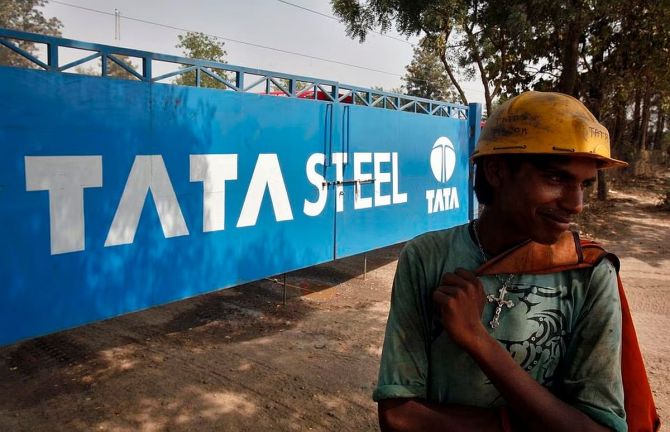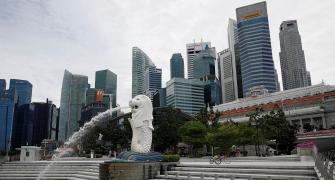vTata Steel has a very British problem.
The performance of Europe dragged the steel major’s October-December (Q3FY23) performance with the UK business accounting for a major part of the operating loss; on the bottom line, the overhang of the British Steel Pension Scheme (BSPS) showed.

And a nearly three-year discussion with the UK government on a support package for a green transition resulted in an offer that fell short of the ask.
The impact of Russia’s war on Ukraine and its fallout on global energy prices, especially in Europe, was not lost on anyone.
As the market slowed and prices tumbled, mills cut production.
Data from SteelMint shows that prices of hot rolled coil (HRC), a benchmark for flat steel, had dropped about 37 per cent from peak levels till December in West Europe.
Yet, a consolidated net loss of Rs 2,223.84 crore was unexpected.
Tata Steel Europe recorded a negative EBITDA of Rs 1,551 crore; at a consolidated level, EBITDA was at Rs 4,154 crore led by the India operations (standalone EBITDA was at Rs 5,334 crore).
The big impact at the profit after tax (PAT) level was a non-cash deferred tax expense of Rs 2,150 crore primarily relating to the movement in BSPS, which the company de-risked by expanding the insurance coverage on its liabilities from 30 to 60 per cent.
The residual insurance of liabilities is expected to be completed in the first half of calendar year 2023.
Analysts believe that the challenges on account of the UK are not going away in hurry.
A Motilal Oswal report said European operations, especially Britain, were expected to face headwinds owing to recessionary pressures in Europe, an overhang from BSPS, increasing coking coal consumption costs, and assets nearing their end of usage life.
Plus, long-term contracts are expected to be repriced at lower rates compared to last year.
Tata Steel Europe’s performance is not a case in isolation, though.
After a post-Covid pandemic boom, the Ukraine war slowed down major economies taking the sheen off steel prices and impacting companies.
But Europe and the UK in particular has mostly been a struggle for the steelmaker since the £6.2-billion acquisition of Corus in 2007 — with write-offs and sell-offs dotting the journey.
The operations in Europe comprise two primary steelmaking units: IJmuiden, Netherlands, and Port Talbot, Wales.
It’s the latter that has largely been the white elephant in the expensive buyout.
Consider this: the UK’s share in the negative EBITDA during the quarter is about 70 per cent; the Netherlands part in it was more of an aberration.
“There have been very few quarters when the Netherlands has been EBITDA-negative.
"It is generally the UK, which has dragged down profitability,” T V Narendran, chief executive officer and managing director, Tata Steel, said.
Of course, the UK operation has also come a long way.
“Around 2015-2016, we were losing a million pounds a day.
"That was the size of the problem,” Narendran pointed out.
“Then we brought it to a range between (-) £100 million and (+) £100 million EBITDA.
"This year also, we were on track. But energy prices, which were already high in the UK, shot up after the war in Ukraine,” he said.
In the pre-war days, energy cost in the UK was double that in Europe.
But in the aftermath of the invasion, it soared everywhere.
The UK government put a price cap, which narrowed the gap.
But Port Talbot comes with its own set of challenges.
Unlike IJmuiden, it is not a well-balanced plant — it buys a lot of electricity from the grid and lacks coke oven capacity or gases.
So, an increase in gas and energy prices hurts it more.
Also, the downstream assets are a constellation of sites across the UK.
As a result, the cost of production is £40-50 more than in the Netherlands and Tata Steel has had to perform a delicate balancing act in optimising production.
The capacity of Port Talbot theoretically is 5 million tonnes (MT) but the targeted operating level has been 2.5-3 MT.
And currently, it’s operating at 70 per cent of that (while the 7-MT IJmuiden is at 90 per cent).
But the fragile side has shrunk over the years — from about 14.4 MT at the time of acquisition.
And as Tata Steel gears up to expand in India — from 21 MT to 40 MT by 2030 — where margins are higher and costs lower, Europe’s influence in the overall scheme of things will diminish further.
The UK plant is also staring at another problem — some of its assets are coming to end-of-life.
That again has put the stability of performance under pressure.
There is a context to it, though.
When the Corus Group was formed from a merger between British Steel and Koninklijke Hoogovens in 1999, investments were made to modernise the Dutch facilities, the British side was stuck in a time warp.
And even as Tata Steel invested more than £1.9 billion in the UK since 2007 (as of 2020), structural issues remain.
The burning issue ahead of it right now is a transition to greener steel, which involves replacing blast furnace with electric arc furnace (EAF) and using locally sourced scrap in the UK. And that would require significant investment.
In the Netherlands, the configuration proposed for the transition uses gas-based and thereafter hydrogen-based direct reduced iron (DRI), melting it in a reducing electric furnace (REF) and then using steel melt shops.
But the company is less dependent on government support here, relatively speaking.
With the UK government, the company has been in conversation for about three years for a support package.
Finally, last month, the government came up with an offer believed to be about £300 million.
But it’s a lot less than what Tata Steel had asked for.
“What we had asked for is something that should have fixed it for good; this is a little sub-optimal,” Narendran said.
The package on the table is being assessed and the outcome will decide the future of Port Talbot.
Last year, the management had said that without support, there could be closure of sites.
But Tata Steel may not throw in the towel yet, especially after a stellar showing by Europe in FY22 when it reported the highest-ever EBITDA of £1.2 billion (UK was at £215 million); in Q1FY23 Europe reported the highest-ever quarterly EBITDA with EBITDA per tonne higher than India.
But the ride has only been good when steel prices are high.
So, what lies ahead for Port Talbot? The answer is, well, still blowin’ in the wind.










